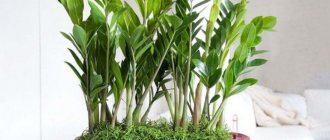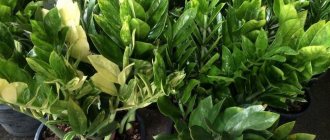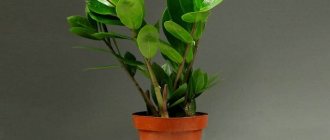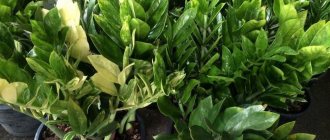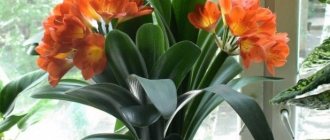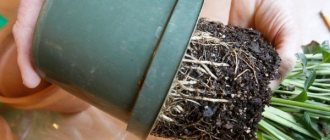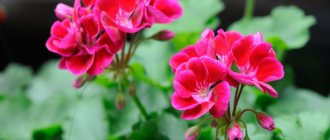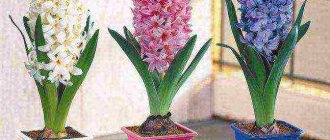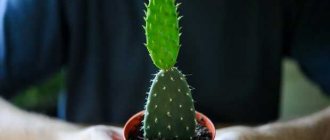Discovered in the tropical forests of Africa, the beautiful Zamioculcas attracted the attention of botanists with its succulent, fleshy leaves. In recent years, it has become very popular, especially after it became known that according to Feng Shui, this flower brings good luck and financial well-being to its owners. Then it was quickly nicknamed the dollar tree and began to be given as gifts for birthdays, holidays, and to decorate offices.
The genus Zamioculcas belongs to the Araceae family. And there is only one species - Zamioculcas zamiifolia (1). However, other types can be found in the literature. For example, Zamioculcas lanceolata - it was described by the German botanist Gustav Peter in 1929, but at the moment it is classified as Zamioculcas similefolia. And Boivin's zamioculcas (Zamioculcas boivinii), which was described in 1870, is now classified as a completely different genus - Gonatopus boivinii.
This plant was first described in 1829. However, it became widespread quite recently - in 1996 (2), when Dutch nurseries began to actively propagate it.
With good care, the dollar tree reaches a height of 1 m or more. It blooms quite rarely, and its light pink or light yellow spadix is not particularly decorative. But the fleshy dark green leaves can delight you all year round. The chairman of the Moscow Flower Growers club, a collector of ornamental flowering plants, Tatyana Zhashkova, told us about the features of this plant
Dollar Tree Varieties
Zamioculcas is very popular not only with flower growers, but also with breeders - they have developed several interesting varieties.
Big Liv yellow (Big leaves var. yellow). This is a very rare variety of Zamioculcas with yellow leaves. At first glance, it seems that the plant is sick and is about to shed its leaves. But no - this is its varietal feature. But its petioles are light green with a purple tint, which makes it even more exotic.
Bug. This is the smallest of all existing varieties - its height does not exceed 30 cm. Its petioles are leafy from the very base, the leaves are dark green.
Zamicro. The very first short hybrid, obtained by breeders in 2007. The height of the bush is about 60 cm. The leaves are much smaller than those of the species plants.
Zenzi. Another low-growing variety - its height also does not exceed 60 cm. The petioles of the leaves are very thick at the base, and the leaves themselves are dark green in color. The variety cannot tolerate waterlogging - it must be watered very carefully.
Lucky. Its main feature is the perfectly rounded shape of the leaves. The plant is up to 55 cm high, grows very quickly - with good care it reaches the size of an adult plant in just a matter of months.
Lucky White (lucky white). This is the most famous variety of the variegated series. Its leaves have a beautiful marble color - cream and yellow spots and streaks are scattered across the green background. The plant is compact, 30 - 40 cm high.
Super Nova. This variety is a luxurious giant up to 1.5 m high. Its petioles are powerful, with an abundance of emerald green leaves.
Black Raven. Its leaves and shoots are so dark in color that from a distance they appear black. At the same time, young leaves are colored light green. The plant looks very extravagant! The bush reaches a height of 75 cm.
Preparing plant food with your own hands
You can also fertilize the plant yourself. Sugar, glucose, potato peelings, castor oil, wood ash, eggshells and even fish bones are great for this.
Dollar Tree Fertilizers
Here are some homemade fertilizer recipes:
- Sugar. Dissolve a tablespoon of sugar in a liter of water. Use no more than once a month. Promotes rapid growth.
- Banana. Pour 2 banana peels with 2 liters of hot water and leave for three days. This fertilizer is rich in potassium, which activates plant growth.
- Yeast. Dilute 11 g of yeast, 2 tablespoons of sugar with 3 liters of water, leave for 2 hours. This fertilizer also affects the growth of the plant and makes the leaves more shiny.
Caring for a dollar tree at home
In general, Zamioculcas is an unpretentious plant, but there are several growing features that need to be taken into account.
Priming
Zamioculcus is a succulent plant, so soil marked “for cacti” is suitable for it.
But you can prepare the soil yourself. The ideal option is a mixture of leaf and turf soil, peat and sand in a ratio of 1:1:1:1. It is useful to add small pebbles and pieces of charcoal to it.
Temperature
During active growth, the air temperature should not be lower than 18 °C, but optimally 25 °C. But in winter, the plant enters a dormant period, and at this time it needs coolness - around 16 °C.
Lighting
The dollar tree loves plenty of light, but does not tolerate direct sunlight - it can cause leaf burn. In summer, this plant feels great on a glassed-in loggia, provided that the sun does not shine directly on it.
Humidity
Zamioculcas has a tuberous root; it is capable of storing water, so it easily tolerates underwatering and drought. It lives quietly without watering for up to 2 weeks - you can safely leave it when going on vacation, or leaving the office for a long vacation.
Zamioculcas is a plant that does not require special care. Photo: @mrlokeshtiwari, pexels.com
But he doesn’t like overflow. If the water sits in the pan, the tuber root may rot. Therefore, drainage and moderate watering are very important. It is necessary to water only when the top layer of soil dries very well.
But at the same time, the dollar tree loves moist air, so it needs to be sprayed every day. It’s even better if it is in a room where there is a humidifier. This is especially true in winter, when the plant stands above a heating radiator.
Fertilizers and fertilizers
Zamioculcas needs feeding only during the period of active growth - from April to September. It is best to use complex liquid fertilizers. There is no need to fertilize it during dormancy.
What does Zamioculcas look like?
Zamioculcas is a genus belonging to the Aroideae family. From the point of view of most botanists, it is monotypic, having a single representative - Zamioculcas zamiifolia or Loddigesii. Others distinguish from two to four varieties.
In nature, Zamioculcas forms continuous carpets of bright green leaves.
The plant is native to the plateaus of southern and southeastern Africa. The conditions there, by human standards, are extreme. But the plant successfully adapted to them. Like most local representatives of the flora, Zamioculcas is a succulent, which is, in principle, atypical for Aroids.
During the short rainy season, it accumulates moisture in thick, fleshy leaf petioles, stems and underground tubers. This “NZ” helps him survive a long drought. If things are really bad for a plant, it sheds its leaf blades, leaving only petioles and veins (axis-rachis). This helps reduce the evaporation area.
The flower owes its name to the fact that its leaves are very similar to the leaves of another African plant - zamia (literally translated “zamioculcas” - “zami-like”). The final name was not approved immediately. The first option (“Caladium zamifolia”) belonged to the famous British lover of exotic flora, Conrad Loddiges. He first described the plant in 1829, but, not being a specialist in the field of botany, mistakenly included it in the genus Caladium, although he was not mistaken with the Araceae family.
The inaccuracy was corrected only in 1856 by an even more famous botanist from Austria, Heinrich Wilhelm Schott. He isolated the plant into a separate genus, “baptized” Zamioculcas and named it in honor of the discoverer. Since the beginning of the 20th century, an intermediate variant has been established in the literature - Zamioculcas zamifolia.
In addition to the official name, the plant quickly acquired many nicknames - “dollar tree”, “eternal” or “araid palm”, “Zanzibar pearl”. Zamioculcas is especially loved in China. There it is considered a symbol of the New Year, and the teachings of Feng Shui connect the owner’s well-being with it.
In China, where the teachings of Feng Shui are especially popular, zamioculcas are often used to decorate the interior of office premises, thus attracting good luck in business
Houseplant lovers appreciate it for the beauty of its leaves. They are glossy, dark green, thin, but quite hard to the touch, and are complex-pinnate in shape. The leaf blade is dissected into 8–12 separate “feathers” - this is also a unique phenomenon for Araceae. Small blurry spots of inky purple color are normal. From a distance, the flower generally seems artificial, because the leaves are very even, one-dimensional.
A Zamioculcas leaf of complex shape is not a separate leaf, but a whole “plate”
Zamioculcas does not differ in growth rate, but at home this is rather an advantage. It often sheds old leaves faster than it forms new ones. The maximum height in captivity is about 1 m.
Zamioculcas has a developed root system. It consists of powerful tubers and thick worm-like roots extending from them. If the plant is not replanted for a long time, the cramped pot, which prevents further growth, may even crack under their pressure.
The root system of Zamioculcas is very developed; it is in the tubers that the plant stores the main supply of moisture and nutrients.
Zamioculcas flowering not only at home, but also in nature is an extremely rare phenomenon. It can only be expected from mature, mature plants. The cob is then covered with large berries, each containing one seed.
Zamioculcas has an alternative, almost unique method of reproduction. The base of the leaves that fall to the ground gradually thickens, turning into a tuber, which then forms roots and goes underground, releasing new shoots.
Reproduction of a dollar tree at home
There are three ways to propagate the dollar tree (Zamioculcas).
By dividing the tuber. The easiest way to propagate a dollar tree is by dividing the tuber. When transplanting an adult plant, the tubers are separated and planted in different pots. The pot for the separated tuber should not be very deep and not very large - about 3 - 4 cm wider than the rhizome.
By cuttings. Cuttings are a more labor-intensive task. First you need to find a bud on a bare branch. Using a sharp knife, cut off the stem with the bud and shorten it slightly - there should be at least one leaf and a bud on the stem. The cut should be sprinkled with activated carbon to disinfect it from possible diseases. Dry the cuttings for 5 - 7 hours (you can leave them on the windowsill overnight).
Pour vermiculite (a special substrate saturated with minerals) into a small pot and slightly deepen the cutting. Water it every day for 2 - 4 weeks, during which time the cutting should give good roots. And then it can be transplanted to a permanent place.
Leaf. A simple, but not always 100% effective method. Moreover, it takes a very long time. Separate several small leaves from the branch, slightly deepen them into loose vermiculite, peat or other substrate. Moisten it a little.
Such “leafy” seedlings need good lighting. You can create a greenhouse effect by covering it with film. The tuber from the leaves forms over several months.
Common growing mistakes
If you follow the basic rules, it is quite possible to get your dollar tree to bloom. To grow zamioculcas, it is necessary to establish a control system and not change the procedure. Even the most experienced gardeners have problems when growing indoor species.
| Problem | Cause | Solution |
| Leaf blades turn yellow completely | Sudden temperature changes, drafts, possible freezing | Change the location of the pot, avoid drafts |
| The tips of the leaves turn yellow | Dry air, high temperature | Humidify the air near the potty, arrange a hygienic shower |
| The leaves turned yellow and completely fell off | Drought, prolonged lack of watering | Transplant the dollar tree into another pot, trim the stems when replanting |
| Slow growth | Transplantation, rest, incorrect choice of container | Avoid root rot and monitor the plant |
| Dark spots on the stem | Rotting of parts of the root system due to overwatering | Stop watering, replant if necessary, after drying the roots with a napkin and removing damaged |
Sometimes gardeners can detect drops of water on leaf blades, although they have not been sprayed or watered by sprinkling. This may mean the plant is crying. This phenomenon signals a violation of watering rules. Excess moisture, excessive air humidity activates the plant’s ability to get rid of water through the leaf plates.
Constant dampness in the tray or excessive humidity around the pot causes pests to appear. Due to dampness, insects such as scale insects and flower midges appear. In summer, you can get rid of them by treating with a manganese solution and moving the pot to fresh air.
Dampness and excessive watering lead to the appearance of fungal diseases. Curlyweed suffers from anthracnose and powdery mildew. When the first signs appear, treat with fungicides. A good option is to manually process the leaves with a solution of laundry soap or tobacco.
Transplanting a dollar tree at home
The roots of Zamioculcas are strong and powerful and can easily break a plastic container, so it is better to plant it in a ceramic or clay container. The pot should be slightly larger than the previous one. A good layer of drainage must be placed at the bottom.
Transplantation must be carried out using the transshipment method, planting the plant in a new pot along with an old lump of earth. But make sure that the top tubers are slightly exposed, about 1 cm.
Important! Dollar tree sap is poisonous and can cause skin burns, so use rubber gloves when replanting it.
Is it possible to keep it at home: the energy of a flower
Esotericists, even without knowing the signs associated with a plant, can determine its energy by its appearance. In the dollar tree it is tough, more offensive than defensive in nature. I see:
- on dense plant covers;
- rachis - the central axes of the leaf, which are mistakenly taken for stems, resemble an arrow pointing upward;
- the segments are shiny, leathery, as if varnished, with a sharp tip.
The harsh energy is softened by a short underground shoot, of which only a small part protrudes above the surface, and resembles rounded nodules. This means that not everything is so bad, and you can “make peace” with the plant.
According to signs, zamioculcas loves the same things as other indoor flowers:
- so that the owners take care of him correctly, and not as they please;
- admired;
- talked;
- treated as a living creature, and not a piece of furniture;
- did not quarrel in the presence of the dollar tree.
Then a hard aura will be beneficial:
- the arrows of the rakhis will not wound the owners, but their ill-wishers;
- the sharp tips of the segments will delay and make malicious witchcraft safe for the home;
- the underground part will collect, neutralize, transform accumulated irritation into positive negative energy, and quickly extinguish conflicts.
Zamioculcas, according to signs, improves the character of cats and dogs - makes them more obedient.
But the main purpose of the dollar tree is to attract large financial flows. This does not mean that you need to spend your last money on zamioculcas, sit between them, and wait for wealth to fall on your head.
According to signs, the flower subtly senses the mood of its owners; due to its tough energy, it is not inclined to pity or indulge in lazy people. It will only benefit hard workers who are unlucky - zamioculcas will string problems onto sharp leaves and connect the owner to the egregor of wealth.
Dollar tree diseases
Root rot. The main problem of Zamioculcas is related to watering - with excess moisture, their roots rot. The problem can be recognized by fading shoots and yellowing leaves.
When caring for zamioculcas, the most important thing is to water it correctly. Photo: @shvets-production, pexels.com
You can save the plant if you start treatment at the very beginning. The first step is to remove the plant from the pot and remove the rotten roots. After that, the remaining ones should be washed in a weak solution of potassium permanganate, dried and planted in a new pot with fresh soil.
Dollar Tree Pests
Spider mite. At the initial stage of infection, it is not easy to detect - the pests are very small. But if numerous light dots begin to appear on the leaves, it’s clearly him. When heavily infested, plants become covered with cobwebs.
The drugs Kleschevit and Fitoverm will help to cope with the pest (3).
Aphid. This pest is clearly visible on plants and cannot be confused with anyone else. With a large population, it can cause great harm, even leading to the death of Zamioculcas.
The preparations Biotlin Tanrek, Karate or the biological preparation Fitoverm will help to cope with aphids (3). Apply pesticides according to instructions.
Scale insects. These insects are covered with a durable shell, settle on all common plants and are not easy to deal with.
The first thing to do is remove the insects with a cotton swab dipped in alcohol. Then wash the plant with soapy water. And then treat the bush with Actellik (3).
Where is the best place to place a plant according to Feng Shui?
First of all, you need to think about safety, not signs. If there is a child in the house who is inclined to put everything in his mouth, the zamioculcas is placed so that he does not reach the plant. It makes sense to take a large interior flower into a room where the baby does not have access.
According to Feng Shui, zamioculcas is located in the southeastern sector, which is responsible for financial flows.


